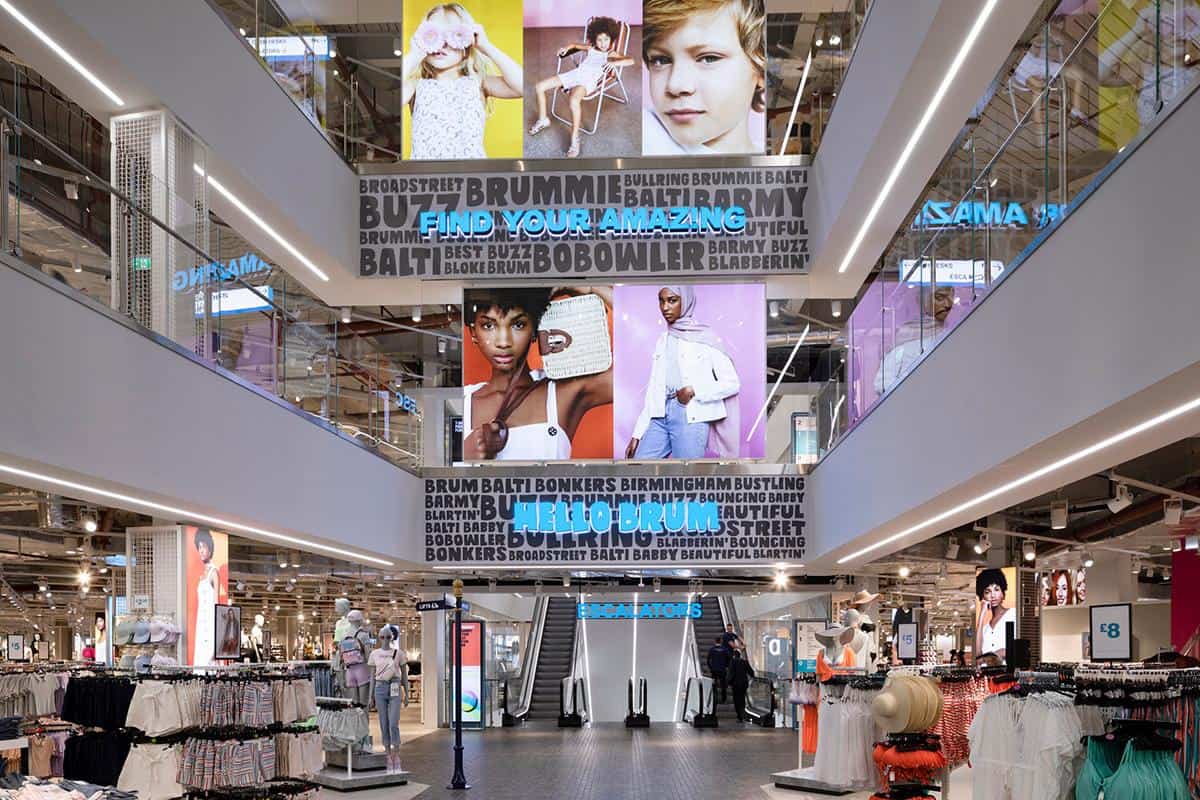Paul Skeldon, mobile editor, InternetRetailing, examines department store 2.0.
Short back and sides. That used to be a really popular haircut in the 1950s. Then it ‘died’… More than half a century later and it is the hipster hairdo of choice. Mix tapes: they died and are now hip again. And vinyl. To paraphrase Pharrell Williams and Chad Hugo, Nothing. Ever. Really. Dies.
And so it is with the death of the High Street. It is trite to say that we are facing a retail apocalypse. Instead, we are facing a less jingoistic – though marvellously alliterative – ‘retail reset’, where the traditional ways of doing things are shifting, driven by changing demands of consumers.
While we have seen many well-known High Street names close their shutters over the past year, with the finger of blame pointed squarely at the internet, what is really happening is that retail is changing. Consumer demands have shifted – admittedly because of the web – and the mix tape making, vinyl-toting, neatly coiffured millennials want a different experience from stores – one that fits in with their lifestyle.
This need for lifestyle-friendly retail is at once the problem and the solution. While the drive for immediacy and low prices are pushing shopping to the web at the expense of the High Street, so too is a desire among these web-enabled shoppers for something more from the shops they visit.
They don’t want what a Debenhams or a House of Fraser had to offer: they want experiences.
Similarly, with town and city centre retail space now going begging, there is a need to look again at how these spaces are used. Many town councils are proposing mixed use offerings, outlining shops, restaurants, entertainment and living all in one place.
Together these factors are driving the change, the retail reset that is causing such turmoil. However, it isn’t all bad. Now that the worst has happened to a number of retailers, those left in the fray – and those waiting in the wings, such as Sports Direct’s Mike Ashley – are poised to act. So, just how is the high street going to change?
GET HIP, DADDY-O
The first thing to bear in mind is that Gen Z and millennials like going to stores. In reality, it is a big – and social, in the traditional sense of the word – element of their shopping process. In a recent study, 58% of 18 to 24 year olds and 60% of 25 to 34 year olds told one of Europe’s leading retail experience design agencies, Foolproof, that they would rather shop for clothes in-store than online.
Peter Ballard, co-founder of Foolproof, explains: “We asked a series of questions pertaining to online verses in-store purchasing behaviours, expectations and drivers. What we found was surprising and runs against the grain of assumptions about digital being the inevitable future for retailers. The fact is that our generations of the future still see a place for the in-store shopping experience, but retailers need to create an experience that plays to the strengths of in-store shopping whilst fixing the pain points that are driving people away.”
He continues: “Retailers have an opportunity, but they need to act now or they will lose out forever. As the digital world continues to mature, we are seeing time and time again that truly beautiful and frictionless experiences are pulling favour.
Some of the advantages of the in-store experience over online shopping, such as the tactile nature of browsing and assessing an item’s quality with your own eyes, may eventually be addressed with advances in technology, but for now those aspects of shopping still have to happen physically, in-store, in person.”
The first step to making the in-store experience more attractive lies in understanding and eradicating what shoppers don’t like about the High Street and moving from there. Foolproof’s research found that 57% of 25 to 34 year olds dislike the crowds and queuing that comes with in-store shopping, 40% dislike carrying shopping around and 36% are put off by travelling and parking. Brands must improve their in-store experience or risk permanently losing customers to the ease of online shopping.
A good place for retailers to start is building some of the advantages of online shopping into the in-store experience. For example, eliminating queuing for checkouts, make home delivery an effortless option, and providing more inspiration and guidance to shoppers.
Brands should also play up the aspects of in-store shopping that cannot be replicated online: the ability to see and feel the quality of products, and the opportunity for a social outing with friends. By considering in-store and ecommerce in tandem, brands can use the strengths and opportunities unique to both to safeguard the future of the high-street.
Interestingly, a study in the US by Kelton Global on behalf of RetailMeNot, found that 85% of US shoppers visit three non-grocery physical retail stores during a typical week – an average that goes up to four stores per week among millennial shoppers and 5.25 among Generation Z. But they do it armed with their phones – using them to research and search, accept offers, share what they are doing and, increasingly, to assess what is happening in a store.
“In-store retail is still the most important channel for consumers and the role that mobile plays in the shopping journey is notable to retailers who want to reach in-store shoppers,” says Marissa Tarleton, ceo, RetailMeNot. “The mobile device is the number one in-store shopping companion, which is a marketing opportunity for retailers to drive in-store footfall, incentivise sales and understand online-to-offline behaviour.”
TAKEN TO THE CLEANERS
While adding technology to stores is the obvious salve for many a retailers fallen footfall, the need to create experiences and make retail a ‘go to’ rather than a has-been requires something else – and some retailers are starting to get what that something else might be.
Dry cleaning may not seem the most revolutionary of retail verticals, but it is pioneering something of a High Street renewal, with two online dry cleaning and laundry services – Laundrapp and Zipjet – merging in April to form what they call “The Uber of Laundry”. Why this is interesting is that the combined company has a wide range of customers across the UK and, while consumers organise their laundry and dry cleaning online, it has to actually be cleaned by franchised dry cleaners.
Online giant eBay is coming at this the other way. It has opened a physical store in Wolverhampton to, in its words, test out how online, mobile and physical retail work together.
The concept store will see 40 local retailers packed into a single space, while shoppers will browse – see, hear, smell, touch, taste – the goods and, if they want to purchase, scan a QR code with their mobile. This allows eBay and the retailer to track who is buying what.
Rob Hattrell, vice president of eBay in the UK, said: “The small retailers taking part in Wolverhampton’s Retail Revival have already shown that physical and online retail can survive – and thrive – together. They have achieved more than £2m in sales as of March and many have employed more staff as a direct result of the partnership. This pop-up store aims to take that growth, and the value of this programme, to the next level. It will explore how stores of the future could combine technology with that vital human connection to powerful effect – whatever the size of the business.”
One business that will be participating in the concept store is Fizzbiz, which sells fabrics, zips, haberdashery and embroidered items online. Fiona Scarrott, who founded Fizzbiz in 2014, said: “The eBay Concept Store is such an exciting opportunity to learn more about physical retail and I’ve been blown away by the opportunities the Retail Revival programme has given me. I’ve received training and mentoring on new topics and skills, and it has taught me many valuable lessons to help develop my business.
“But it’s not just about getting to take part in the Concept Store – Retail Revival has opened so many other doors for Fizzbiz, which started as a hobby. In the last six months my turnover has almost doubled, helping fulfil my dream of building a workshop in my garden to let me focus on my business.”
Mainstream retailers are also delving into this mobile-physical nexus as part of their plans to revamp retail. Take Primark, for instance. It has opened its biggest UK store yet in Birmingham’s Bullring Shopping Centre – a brave move if we really were in a retail apocalypse. The retailer doesn’t sell online, but still has to compete with all those that do and it has to do more than sell three boob-tubes for a fiver to win.
Its answer has been to rethink what this enormous store is for. While it has its usual plethora of cheap fashion, it also features a number of franchises – including one from Disney – and a range for kids. But it is the non-core activities that it has built in that are most noteworthy.
The store features cafes and restaurants, a bar and numerous chill-out areas with free device charging. It also features a trendy barbers.
Yes, all those lads accompanying their ladies on a shopping pilgrimages can keep their short-back and sides (and their beards) looking lovely while they wait.
Primark’s director of new business development, Tim Kelly explains: “Our customers can expect a great experience at Primark Birmingham High Street. They can spend time with friends and family, eat great food, recharge and have fun, and find everything under one roof including Fashion, Beauty and Homewear – all at an amazing price. We’re proud to bring this great store and everything it has to offer, to Birmingham.”
The real genius of this – not just the barber, but also the restaurants, cafes, bar and charging stations – is that suddenly a trip to just that one store can kill numerous birds with one stone. It is no longer a trip for the missus to buy clothes, but it is also a place to get something to eat, meet friends and get your haircut, catch up on the football and charge your phone ready for a big night out in downtown Dudley.
In the more salubrious streets of Chicago, athletics clothing seller Lululemon is doing similar. The retailer, famed for its yoga pants, is revitalising a number of its stores to include other reasons to visit: a yoga studio, mediation areas, juice bar, cafe and ‘community gathering areas’.
These will bring in outside experts to do classes on yoga, meditation and healthy eating and lifestyle and is part of the retailer’s plan to grow its reputation, along with its store footprint, in the US and soon Europe and China.
Again, mobile plays the crucial role in being where would-be visitors discover what is happening that day and, furthermore, book the classes they want to take. Lululemon also uses mobile to update its loyal customers as to what is happening and sends them offers to sign up first.
This move to experience and ‘community’ has also been picked up by Pets at Home. It has opened two new ‘stores of the future’ in Stockport and Chesterfield, offering what it says will be “an immersive experience for shoppers, complete with in-store vet practices and groom rooms”.
PET VILLAGES
According to the retailer, Pets at Home’s stores are being transformed into innovative ‘pet villages’, featuring dog washing stations, selfie spots and pet care classes. The new format will also see the launch of Pets at Home’s first cat adoption lounge and will work in partnership with the RSPCA to welcome those considering adopting a cat. With all services and products integrated under one roof for the first time, it truly is a one stop shop for pet lovers.
The new stores will also feature dedicated events areas where customers can learn about the importance of dog grooming during a live demonstration, join like-minded owners at the monthly breed socials, or see how fast their dog is on the agility course. Pet owners will also be able to book free food consultations with a nutrition adviser, as well as conducting weight checks for their pets.
They can also take advantage of the self-wash station, where they can wash and blow-dry their dogs in the purpose-built facilities – without having to make a mess of the bathroom at home.
Peter Pritchard, group ceo, explains: “We’ve always known that our stores are much more than just a convenience shop for pets and now we’re providing them with the million-pound makeover they deserve. The store of the future is a destination for all pet lovers to shop, learn and pamper.
The retail industry is constantly evolving, and many retailers are only targeting resources towards online platforms. We believe that this competitive landscape requires a combined online/offline offer to ensure the ultimate in convenience and personal service for our customers.
Our Store of the Future boosts our offering for pet owners, with people, personality and, most importantly, pets at the centre of our business.”
This sense of people – and pets – at the centre of the experience, based around not only giving people what they want, but also what they like to do is going to be crucial in managing the reshaping of in-store retail.
Creating experiences from adding new dimensions to the store, ideally from hip third parties such as cool barbers, trendy juice makers and even zen-like yoga teachers are all part of the process.
What is interesting is that, while on the face of it adding a juice bar and opening up to cool new franchisees looks revolutionary, really it is exactly the same model as the department stores of old that it seeks to replace.
This is why it isn’t so much a retail apocalypse as a retail reset. It looks a bit different, but really it just requires some different kinds of franchises to appeal to today’s very different shopping demands. And that should make us all, as Pharrell so famously and eloquently put it, happy.





